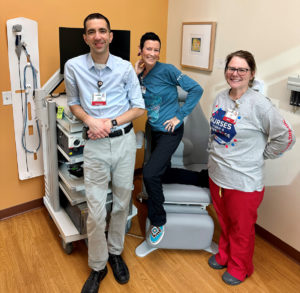
Clinicians within the Division of Gastroenterology, Hepatology, and Nutrition are promoting a new endoscopic procedure for pediatric patients that saves time, money, and discomfort. Jonathan Wong, DO, assistant professor, Divisions of Gastroenterology, Hepatology, and Nutrition and Global Pediatrics, serves as the director of endoscopy at American Family Children’s Hospital (AFCH). Wong and his team performed AFCH’s first unsedated transnasal endoscopy (TNE) in February of this year. Although pediatric TNE has been present for the last one to two decades, adoption has been slow and evaluation has been limited to the most proximal parts of the GI tract, primarily the esophagus. FDA approval for a single-use endoscope capable of reaching the same areas as a traditional endoscope occurred in 2022.
The new TNE device replaces the larger-sized gastroscope that is inserted into the throat, then esophagus, stomach, and upper portions of the small intestines for visual inspection and biopsy collection. Performing a TNE procedure involves insertion of the much smaller endoscope (with an outer diameter of 3.3 mm — half the size of a #2 pencil) through the nose and into the esophagus and beyond. Examination can be conducted in a clinic office setting with only a lidocaine analgesic spray for nose and throat. Patients are offered virtual reality goggles for distraction, but no sedation is needed and the child can return to school immediately afterward.
Currently, the majority of esophagogastroduodenoscopies (EGDs) are performed in the AFCH OR under general anesthesia. “The thing that interests families most about this new procedure is that it does not involve sedation,” Wong reported. “Diagnostic endoscopy in pediatrics is safe and common, but many parents express concerns about the sedation piece.”
This new technique is of particular interest to patients with a diagnosis of eosinophilic esophagitis (EoE), a condition that causes inflammation of the esophagus. Children with EoE can experience pain with swallowing even small amounts of food and often suffer stressful choking. While there are medication options for these patients, some families may choose dietary elimination. By excluding certain foods from the diet, principally six common food allergens — milk, egg, wheat, soy, fish, and nuts — a clinician can determine which are the specific food triggers. This process is called the six-food elimination diet. An upper endoscopy is used to evaluate the effects of each food as it is added back to the child’s diet. It’s possible that an EoE pediatric patient could require seven or more upper endoscopies, one every three months, during the long course of a treatment that includes the six-food elimination diet.
“It takes a lot of resources to do an upper endoscopy,” Wong explained. “It includes time, rooms, and multiple personnel, not to mention the disruption and inconvenience for the child and family.”
While traditional EGD takes only five minutes from scope insertion to removal, time in the hospital can be over three hours, requires at least six staff members, and consumes expensive operating room time. Beyond those easily calculable costs, the pediatric patient must recover from anesthesia — and may not feel well enough to return to school for the day. Furthermore, parents may have had to take time off work to bring the child in for the procedure.
The fact that the new procedure is performed in an office and not the OR reduces the cost. “When you do the TNE in the office, it takes only two to three people,” Wong reported. “The new TNE procedure, in the office, takes about five to 10 minutes. If you include registration, consent, and a brief post-procedure observation period, you’re looking at roughly 30 to 60 minutes in the office for the child and parents — then immediately back to activity as usual.”
“One of my goals has been trying to move some of these cases out of the OR so we can have that space for more complex cases,” Wong added.
Beyond the benefits of TNE that Wong described at AFCH, there is a possible use for this smaller, less expensive, and recyclable endoscope in low-resource countries. Wong’s global pediatrics interest has focused his attention on how this technique could improve access to endoscopic procedures among underserved populations.
Wong believes that the new technique has the potential to replace standard EGDs, conducted for a variety of indications such as duodenal biopsies for celiac disease and H. pylori testing. “Anything we would want to do from a diagnostic standpoint with a standard scope, we can do with the new smaller transnasal scope,” Wong said. “We are not quite there yet, but I believe it’s coming.”